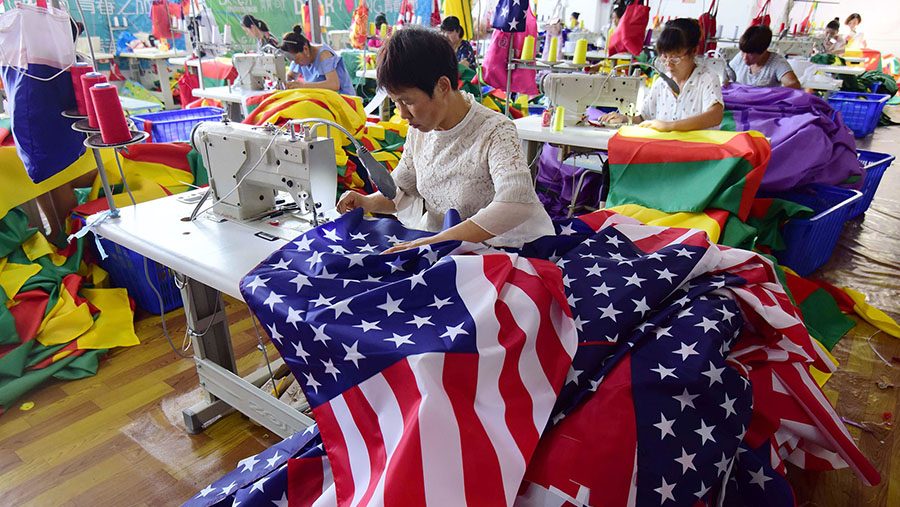The expected tariff news hit on Monday, March 3, of a big news week related to the economy, starting with the Manufacturing PMI reports for February and ending with the Jobs Report on Friday, February 28.
With all the angst in the market, the National Retail Federation (NRF) still sees a strong economic performance it saw in 2024 carrying over and influencing growth in 2025 but there is wide-ranging uncertainty as the White House and U.S. Congress make decisions that will impact the economy, suggested NRF Chief Economist Jack Kleinhenz.
“While the U.S. economy has entered 2025 with a fair amount of momentum, the mix of policies being debated on immigration, tariffs, deregulation, and taxes blur the economic outlook and its narrative, with many crosscurrents at work,” Kleinhenz said. “While deregulation and tax cuts could provide positive momentum, immigration restrictions and tariffs could be a drag on the economy and have adverse effects. Although recent economic data remains strong, we are concerned about the downside risks.”
The note from Kleinhenz came before two February Manufacturing PMI Index reports that had Wall Street abuzz in the morning about a potential slowing in the economy as job growth weakened and input cost inflation reached its highest level in over two years.
Looking at the February Manufacturing PMI from the Institute for Supply Management ISM, the report outlined that economic activity in the manufacturing sector expanded for the second consecutive month in February after 26 straight months of contraction.
The ISM Manufacturing PMI registered 50.3 percent in February, 60 basis points lower compared to the 50.9 percent level recorded in January. ISM said the overall economy continued to expand for the 58th month after one month of contraction in April 2020.
ISM said a Manufacturing PMI above 42.3 percent over some time generally indicates an expansion of the overall economy.
The ISM reports saw the New Orders Index drop back into contraction territory after expanding for three months, registering 48.6 percent, 6.5 percentage points lower than the 55.1 percent recorded in January.
The February reading of the Production Index (50.7 percent) is 1.8 percentage points lower than January’s figure of 52.5 percent.
The Index expanded for the second month in a row after eight months of contraction.
According to ISM, the Prices Index surged further into expansion, or “increasing,” territory, registering 62.4 percent, up 7.5 percentage points compared to the reading of 54.9 percent in January.
The Backlog of Orders Index registered 46.8 percent, up 1.9 percentage points compared to the 44.9 percent recorded in January.
The Employment Index registered 47.6 percent, down 2.7 percentage points from January’s figure of 50.3 percent.
ISM added several comments collected from various manufacturing sectors, including:
- “The tariff environment regarding products from Mexico and Canada has created uncertainty and volatility among our customers and increased our exposure to retaliatory measures from these countries.” [Chemical Products]
- “Customers are pausing on new orders as a result of uncertainty regarding tariffs. There is no clear direction from the administration on how they will be implemented, so it’s harder to project how they will affect business.” [Transportation Equipment]
- “Tariff impact has been minimal to overall manufacturing and raw material supply. Limits on U.S. government spending in key organizations like the Food and Drug Administration, Environmental Protection Agency and National Institutes of Health are delaying some orders.” [Computer & Electronic Products]
- “Inflation and pricing pressure continue to drive uncertainty in our 2025 outlook. We are seeing volume impacts due to pricing, with customers buying less and looking for substitution options.” [Food, Beverage & Tobacco Products]
The S&P Global U.S. Manufacturing Purchasing Managers Index (PMI) rose to 52.7 in February 2025, surpassing the preliminary estimate of 51.6 and improving from January’s 51.2.
S&P Global said the reading signaled the second consecutive month of expansion in the sector and the strongest growth since June 2022. However, there was some evidence that the expansion was partially driven by advanced purchases in anticipation of potential price increases and supply disruptions linked to expected tariff impositions in the coming months.
Output grew at the strongest pace since May 2022, while new orders rose at the fastest rate in a year; however, the pace of job creation slowed from the previous month.
On the price front, input cost inflation reached its highest level since November 2022, while output charge inflation accelerated to a two-year high, suggesting that some suppliers were adjusting their prices upward in response to tariffs.
This comes as President Trump signed an Executive Order on Monday afternoon, March 3, raising China tariffs by 10 additional percentage points to 20 percent. Those tariffs will take effect at midnight tonight. Trump is expected to apply new tariffs on Mexico and Canada and told CNBC that time had run out to work out a deal with those two close neighbors.
“Weak consumer perceptions and uncertainty from the lack of clarity regarding future government policies and regulations can significantly hinder business operations,” Kleinhenz added. “That, in turn, can cause a hesitation in consumer spending and make it difficult for companies to make investment and hiring decisions. We are watching carefully and hoping for the best as much depends on how and when these policies are put in place.”
Kleinhenz’s comments came in the March Edition of the NRF’s Monthly Economic Review, which said gross domestic product adjusted for inflation grew 2.8 percent in 2024, with “robust“ consumer spending “fueling economic activity and making a consistent contribution to growth.“
Overall consumer spending unadjusted for inflation was also up 2.8 percent year over year in 2024 and retail sales, excluding auto dealers, gas stations and restaurants to focus on core retail, were up 3.6 percent unadjusted.
The NRF said consumers “remained engaged“ in January, with core retail sales slipping 0.9 percent from December after a vigorous holiday season but rising 4.2 percent year over year, showing that “consumer fundamentals in early 2025 are still strong and are not showing significant indications of stress.”
Job and wage growth have supported consumer spending, and while the 143,000 jobs added in January were down from 207,000 in December, the unemployment rate fell to 4 percent after holding between 4.1 percent and 4.2 percent since last June. The data shows signs of worker scarcity rather than slack in the labor market.
Inflation increased more sharply than anticipated in January, with the Consumer Price Index up 3 percent year-over-year compared with 2.9 percent in December and producer prices were up 3.5 percent.
Inflation has been rising since last October, and Kleinhenz said “the critical question is whether the trend will continue. Given the hot January inflation readings for consumer and producer prices alike, the Federal Reserve is unlikely to cut interest rates anytime soon.”
Consumers surveyed for the University of Michigan’s Index of Consumer Sentiment in February said inflation will rise to 4.3 percent this year, up from 3.3 percent expected in January. That’s the highest inflation expectation since November 2023 and “likely reflected a concern about tariff-induced price increases,“ Kleinhenz said. The new number came as the Index dropped to a low reading of 64.7 in February from 71.7 in January, marking the second monthly decline after five months of small gains.
















